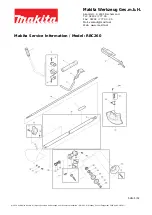
4
Fig. 5
Fig. 6
FENCE
To move the fence, loosen the fence locking lever Fig. 5
(A) and slide across table to desired position. As the
fence moves across, the cutterhead is guarded behind
to avoid any exposed blades. Do not forget to tighten
fence locking lever securely before operating machine.
To tilt fence, loosen lever, Fig. 7 (A) release the plunger
Fig. 8 (A) and angle the fence foreward or back using
the fence tilting lever.
ADJUSTING POSITIVE STOPS ON FENCE
The positive stops on your jointer allow you to set fence
positions of 90 and 45 degrees and allows you set
these positions without measuring each time.
Loosen lock handle Fig. 7 (A) and move fence to 90
degrees and position end of plunger Fig. 8 (A) in the
notch of the index collar Fig. 8 (B). If the fence is not at
exactly 90 degrees to the table, loosen the set screw
Fig. 8 (C) in the index collar and with lock handle Fig. 7
(A) released, establish the exact position required with a
combination square. Tighten set screw Fig. 8 (C) and
lock handle.
To set the fence to 45 degrees facing out, loosen lock
handle Fig. 7 (A), establish position at 45 degrees,
loosen lock nut Fig. 8 (A), and turn adjustment screw
Fig. 8 (B) so it touches the fence and creates a stop.
Tighten lock nut Fig. 8 (A) and and lock handle, Fig. 7
(A).
To set fence at 45 degrees facing in, the process is the
same as above, but when adjustment is needed, loosen
lock nut Fig. 8 (F), and turn adjusting screw Fig. 8 (G)
until fence is exactly 45 degrees and touches top of
adjusting screw Fig. 8 (G). Tighten lock nut, Fig. (F) and
lock handle Fig. 7 (A).
Fig. 7
Fig. 8
A
A
A
C
D
E
F
G
B
Содержание CTJ-350
Страница 2: ... 8 JOINTER MODEL CTJ 350 INSTRUCTION MANUAL ...
Страница 10: ...9 ...
Страница 11: ...10 ...
Страница 12: ...11 ALL ELECTRICAL WORK SHOULD BE UNDERTAKEN BY A LICENSED ELECTRICAL CONTRACTOR ...






























